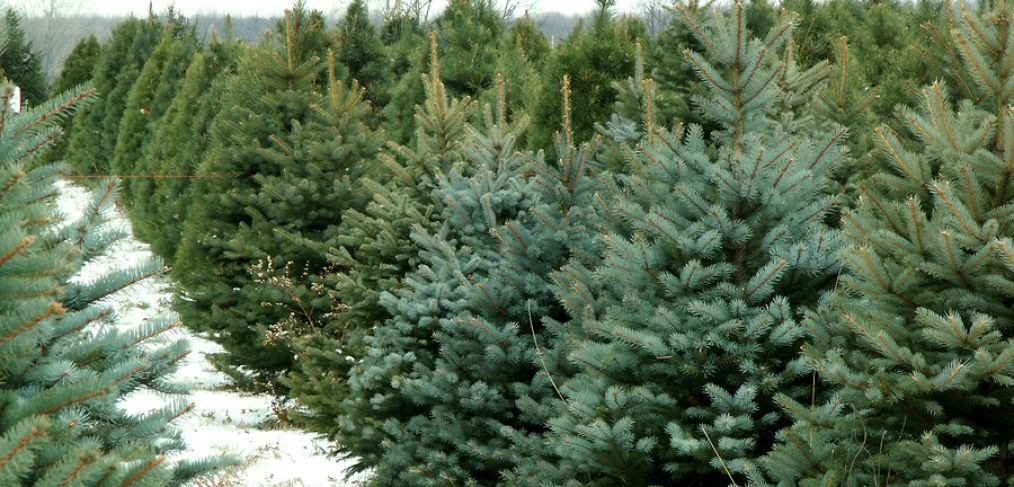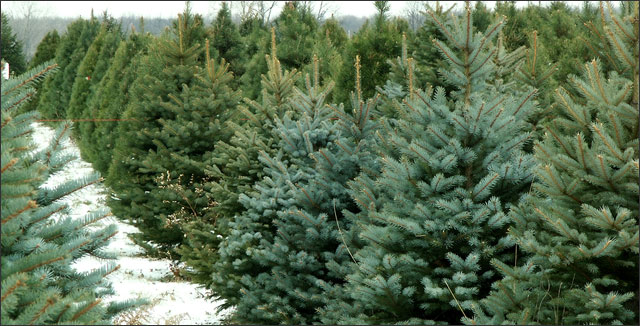
Christmas Tree Farms: The History and Economics of Growing Conifers

I don’t know about you, but I like to see where my Christmas tree is growing and cut it down myself every year. I love to watch children wander around the land where the trees are all growing and speculate about which tree will look best nestled in the corner of our home decked with lights and special ornaments.
At home, I especially love that first whiff of pine when we’ve brought in our bit of the outdoors. It’s even better with a cup of hot cocoa, some Christmas music playing in the background, and snow falling outside the window.
No offense to the workers manning the tree lots in metro areas or at the local hardware store – goodness knows their hours spent in the freezing cold helping customers is a thankless job – but walking through rows of already-cut and balled trees just doesn’t do it for me. Of course, you still get that pine smell and a living tree, which is great. Additionally, you still get to support what is probably a local, and small-time, farmer – which is even better in my book.
The Birth of Christmas Tree Farms
Do you know that before 1901 there were no Christmas tree farms at all? The first one was a Norway Spruce farm near Trenton, New Jersey – probably sewn when the farmer there saw a potential market to city-dwellers. Still, most people journeyed into forest land to cut their own for free until the 1940’s.
It’s still possible to obtain a permit from the U.S. Forest Service or the Bureau of Land Management to cut your own tree from government land within the National Forest system. This sounds like it could be a lot of fun – especially if you have older kids who are up for a trek and won’t need to be carried themselves by the end of the journey!
Starting Your Own Christmas Tree Farm
For the rest of us, a cut-your-own tree farm is right in our sweet spot. It’s a great way for a small-time farmer or even a hobby farmer to make a great return on a small amount of land.
It’s possible, if you’re a gardener yourself and you have an acre or two you could use, you could get in the Christmas tree business yourself. It’s certainly labor-intensive for part of the year, but if you do most of the work yourself, you’ll get to keep most of the profits – mowing, weed control, shearing and pest control are manageable things to do for a hobby farmer.
Most trees are ready to harvest at an average of eight years. You can plant about 1,500 trees per acre and if you re-plant about 1/8th of your acreage every year you’ll have a steady income. It seems like live tree prices go up every year. Some of this is markup costs for the distribution companies – which are needed, by the way.
Not every farmer wants to offer customer service. However, at an average of $46 per tree, if you have 200 harvestable trees per acre, that’s $9,200! In addition, this is also a green business. Planting trees on your land provides erosion control and a home for wildlife.
What Christmas Trees Need to Thrive
Here are some specifics about what Christmas trees need to thrive. The trees you’ll find in lots or at U-Cut farms will be pine, spruce or fir trees. The most popular in the US – depending on where you’re looking – are Balsam fir, Douglas-fir, Scots (or Scotch) pine and Fraser fir.
Trees are like any plant in that they need specific nutrients to do well. Hydrogen, carbon and oxygen come from air and water. The other elements they need from soil or fertilizer: nitrogen, phosphorus, potassium, calcium, magnesium, sulfur, boron, copper, chlorine, manganese, molybdenum, iron and zinc.
It’s a good idea to test your soil before you consider sowing an acre or so of trees to see what fertilizer they might need. You also need to consider the pH balance of your soil and its drainage.
Pine trees are better adapted to sandy or sandy loam soil white spruce trees and fir trees – like the Douglas-fir – prefer fine textured loam and clay loam soils. In all cases, if you don’t have soil that drains well, you’re not going to make a profitable business in Christmas tree farming.
Popular Evergreens at Christmas Tree Farms
Balsam fir is most popular in areas of the country with cold winters and cool summers. It has a natural cone shape so it needs less shearing than other varieties.
Douglas fir is the most widely grown variety of Christmas tree grown in the northwest U.S. It hold its needles like a champ after cutting – long after other trees shed theirs all over your floor. It’s also naturally cone shaped so it needs minimal shearing. These trees prefer a milder growing climate with well-drained soil.
Scotch pine trees are popular for farmers. Because of their deep tap roots, they weather drought better than other varieties and they grow fast in a wide range of soils and climates. This kind of tree is more high-maintenance in the shearing department. It’ll get wild-looking and be un-sellable if it’s not pruned and shaped.
Other Considerations
Another consideration is whether the land you have is relatively level and free of obstructions. If your land is too hilly, there will be too much erosion to support coniferous trees properly. Sometimes trees can be sewn successfully on less desirable acres of land but they generally need land free of boulders, woody plants and weeds and other obstructions in order to thrive.
Some varieties, like the Fraser fir are unable to grow at all on low-quality land. Also, like all conifers, Christmas trees can be plagued by pests. Some can have problems with diseases as well. The Douglas-fir industry is notoriously plagued by the plant pathogen, Rhabdocline weirii, which affects only Douglas-firs.
Take Away
Whether you are in the market for a Christmas tree, interested in growing your own, or maybe stepping up your game to include a few outside sales, this topic has many interesting points.
Do you dream of owning your own business using your gardening skills? Do you have land you could use for this? Do you know anyone who does this on the side? How would you start, if you were going to get serious about Christmas tree farming? We would love for you to share your thoughts in the comments below.



